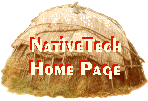
moccasins with hair filled
tinkling cones on fringe
(Amer. Ind. Art. Autumn 1995).
Tinkling Cones ~ Past & Present Traditions

|
|
Iroquois ~ Center seam moccasins with hair filled tinkling cones on fringe (Amer. Ind. Art. Autumn 1995). |

|
|
Huron ~ 1790-1820 ~ pouch with red deer hair filled cones ( Amer. Ind. Art Winter 1995) |
By the 1600's Native Americans of the Northeast had acquired a wealth of knowledge for working European sheet metals which was no doubt combined with experience in indigenous copper before contact. Even the tiniest pieces and scraps of copper and brass were recycled. Native Americans of New England mastered techniques of cutting, drilling, etching, forming, joining, and decorating indigenous and European sheet metal. Because of the skill required to make many of the rolled and riveted items, and because of the similarity between items made by both coastal and interior groups of Natives, there may have been Native metal work specialists who traded their products inland (Wray et. al. 1987).

|
|
Jingle dress dancers at the Oglala Nation powwow in 1992 ( Amer. Ind. Art Autumn 1994) |

|
|
Bull tail (hair piece) with quill work & feather filled cones ~ Amil Blue Legs ( Amer. Ind. Art Winter 1995) |
A favorite Native American ornament for the past three centuries is a sheet metal trapezoid, rolled into a cone, and attached to knifesheaths, pouches moccasins, or other clothing (Beauchamp 1903). These ornaments are commonly referred to as tinkling cones. In the northeast, tinkling cones were often attatched to leather bags ornamented with embroidery of dyed porcupine quills (Quimby 966). Brass tinkling cones from the 1600ís are even found among the Archaeological Collections of State of Connecticut. Tufts of dyed deer or other fur or feathers were often inserted into metal tinkling cones. In New Netherland in 1650 Native Americans "have long deer's hair which is dyed red, and of which they make rings for the head, and other fine hair of the same color to hang from the neck like tresses, of which they are very proud" (Anonymous 1967).

© 1994-1999 Tara Prindle.